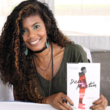Apple: Skin to the Core
(Libby/OverDrive eAudiobook)
Available Platforms
Description
More Details
Similar Titles From NoveList
Similar Authors From NoveList
Published Reviews
Booklist Review
Gansworth (If I Ever Get Out of Here, 2013), a tribally enrolled Onodaga living among the Tuscarora, offers a memoir in verse and lyric prose. Playing off the derogatory term apple (red on the outside; white on the inside), often used in Native communities, he explores the realities of growing up on the rez, being subjected to racism and poverty, and learning to navigate the white world. In ambitious thematic sections recalling Beatles albums (e.g., The White Album here becomes "The Red Album," Abbey Road morphs into "Dog Street"), poems recount his grandparents' experiences in residential schools; his lifelong love of the Beatles and superhero comics; family influences, including his largely absent father; and his strong sense of Indigenous identity that survives despite leaving the rez. Several poems parallel Beatles' lyrics ("Come Together" and "Here Comes the Sun"); some push back against stereotypes ("If you excel, you will be 'remarkable for being an Indian'"); and still others point to the dangers of "browsing with too much melanin." Gansworth's art, a mix of gouache paintings, photographs, and collages (reproduced in black and white), is interspersed throughout, adding interest and detail. With language rich in metaphor, this is a timely and important work that begs for multiple readings.
Publisher's Weekly Review
Originally conceived as a series of paintings, this ambitious memoir in verse by Gansworth (Give Me Some Truth), an enrolled member of the Onondaga Nation, explores intersectional identities alongside matters of generational and personal experience, erasure, and memory: "So much of my culture feels on the verge of vanishing. I wonder what part of that I'm contributing to with my own lack of knowledge." Gansworth first describes his family's history, beginning with his grandfather's time in Native American boarding schools, where "you are being taught systematically to forget so that you will have nothing left to pass on to your children." Subsequent sections detail variations on feeling like an outsider: Onondaga Gansworth's childhood on a Tuscarora reservation, the way his early interest in art and pop culture (Batman, the Beatles) made him stand out among his peers, and his adulthood as a gay man after leaving the reservation. Phrases and concepts circle and repeat throughout--"apple," for example, appears both as a pejorative ("red on the outside, white on the inside") and in reference to the Beatles' Apple Records, after which the work is structured--creating a raw, layered story about love and loss of community, culture, and place. Family photos, black-and-white reproductions of the author's paintings, and project "liner notes" round out the telling. Ages 12--up. Agent: Jim McCarthy, Dystel, Goderich & Bourret. (Oct.)■
School Library Journal Review
Gr 7 Up--This bittersweet but ultimately inspiring memoir in verse chronicles Gansworth's experience raised on a reservation. Gansworth, who is an enrolled Onondaga writer and artist, was born and raised at the Tuscarora Nation. The text aims to illuminate the truth about his family history and the trauma that shaped Gansworth's life. Black-and-white photos and original graphic art supplement the text. The book's very effective format creates emotional resonance. The straightforward narrative showcases themes of betrayal, racism, struggle, acceptance, resilience, risk, coming of age, and the power of family and community. The text opens by confronting and reclaiming the slur "Apple," which is a derogatory term used to describe a Native person who is "red on the outside, white on the inside." Gansworth's deft storytelling skills shine; he is not afraid to examine uncomfortable truths. He writes honestly about the appropriation of Native American songs and dances, the effects of boarding school on both sets of grandparents, learning his native language, longing for his father's approval, friendship, feeling lost, and leaving home for college. Throughout the narrative, he incorporates references to pop culture, such as television programs, movies, Batman, comic books, the Beatles, KISS, and Pink Floyd. All teens will relate to Gansworth's profound portraits of joy, pain, and hope. VERDICT A well-written and captivating autobiography about the modern-day Indigenous experience that should be widely shared. Recommended for middle and high school libraries.--Naomi Caldwell, Alabama State Univ., Montgomery
Horn Book Review
Gansworth, an enrolled member of the Onondaga Nation, grew up on the Tuscarora reservation, making him always "the outsider inside." The theme of being an outsider appears frequently in this memoir in verse. So does the complicated legacy of Indian boarding schools, which three of his grandparents attended, and the slur "Apple," meaning "red on the outside, white on the inside" (based in assumptions that the author challenges). Gansworth's first-person narrative tells a deeply personal story, full of family history and references to popular culture. As in his novel If I Ever Get Out of Here (rev. 9/13), the music of the Beatles is central, with section titles alluding to the band's history and Abbey Road songs providing poem titles within one section. The full pages of mostly long-lined, sometimes dense verse (including some prose poems) are occasionally relieved by Gansworth's gouache illustrations, featuring a complex interplay of images from popular culture and traditional wampum belts documenting and celebrating "survival and cultural continuity," and by photographs gathered from various sources. This introspective memoir confirms by its very existence that, though the boarding schools tried to erase Indian culture, Native peoples "are still / here, / still standing, still walking, one resilient step at a time." Back matter includes further information about the author's poetry and art and explains musical connections. Dean Schneider November/December 2020 p.124(c) Copyright 2020. The Horn Book, Inc., a wholly owned subsidiary of Media Source, Inc. No redistribution permitted.
Kirkus Book Review
Native American identity issues are explored in this ambitiously structured memoir in verse. Gansworth (Onondaga) grew up among Tuscaroras. A minority on his reservation, his identity was further complicated by tribal intermarriage and the fact that three of his grandparents suffered forced assimilation in Indian boarding schools. Fascinated with Batman and masks, his boyhood was spent looking for a costume that would reveal his true self. His mother warned "it's a white man's world" while also acknowledging that Gansworth himself seemed destined for more. The memoir is high concept, structured like a palimpsest over the Beatles' oeuvre. The title alludes to the Beatles' Apple Records as well as the Native slur that implies someone is "red on the outside, white on the inside." Written in a nostalgic tone, the book emphasizes cultural dislocation: "So much of my culture feels on the verge of vanishing. I wonder what part of that I'm contributing to with my own lack of knowledge." Gansworth's take on his great-uncles' "erasing themselves too fully to ever come home" complicates his efforts to reclaim the pejorative. From his childhood to his life as a college student and writer, the book skims over a lifetime; feelings of intimacy and emotional intensity are variable even as the elliptical voice is unique. Black-and-white reproductions of Gansworth's paintings and family photographs enhance and extend the text in a work originally conceived of as a visual arts project. A rare and special read. (liner notes, section notes, note about the art) (Verse memoir. 12-18) Copyright (c) Kirkus Reviews, used with permission.
Booklist Reviews
*Starred Review* Gansworth (If I Ever Get Out of Here, 2013), a tribally enrolled Onodaga living among the Tuscarora, offers a memoir in verse and lyric prose. Playing off the derogatory term apple (red on the outside; white on the inside), often used in Native communities, he explores the realities of growing up on the rez, being subjected to racism and poverty, and learning to navigate the white world. In ambitious thematic sections recalling Beatles albums (e.g., The White Album here becomes The Red Album, Abbey Road morphs into Dog Street), poems recount his grandparents' experiences in residential schools; his lifelong love of the Beatles and superhero comics; family influences, including his largely absent father; and his strong sense of Indigenous identity that survives despite leaving the rez. Several poems parallel Beatles' lyrics (Come Together and Here Comes the Sun); some push back against stereotypes (If you excel, you will be 'remarkable for being an Indian'); and still others point to the dangers of browsing with too much melanin. Gansworth's art, a mix of gouache paintings, photographs, and collages (reproduced in black and white), is interspersed throughout, adding interest and detail. With language rich in metaphor, this is a timely and important work that begs for multiple readings. Grades 10-12. Copyright 2020 Booklist Reviews.
Publishers Weekly Reviews
Originally conceived as a series of paintings, this ambitious memoir in verse by Gansworth (Give Me Some Truth), an enrolled member of the Onondaga Nation, explores intersectional identities alongside matters of generational and personal experience, erasure, and memory: "So much of my culture feels on the verge of vanishing. I wonder what part of that I'm contributing to with my own lack of knowledge." Gansworth first describes his family's history, beginning with his grandfather's time in Native American boarding schools, where "you are being taught systematically to forget so that you will have nothing left to pass on to your children." Subsequent sections detail variations on feeling like an outsider: Onondaga Gansworth's childhood on a Tuscarora reservation, the way his early interest in art and pop culture (Batman, the Beatles) made him stand out among his peers, and his adulthood as a gay man after leaving the reservation. Phrases and concepts circle and repeat throughout—"apple," for example, appears both as a pejorative ("red on the outside, white on the inside") and in reference to the Beatles' Apple Records, after which the work is structured—creating a raw, layered story about love and loss of community, culture, and place. Family photos, black-and-white reproductions of the author's paintings, and project "liner notes" round out the telling. Ages 12–up. Agent: Jim McCarthy, Dystel, Goderich & Bourret. (Oct.)¦
Copyright 2020 Publishers Weekly.School Library Journal Reviews
Gr 7 Up—This bittersweet but ultimately inspiring memoir in verse chronicles Gansworth's experience raised on a reservation. Gansworth, who is an enrolled Onondaga writer and artist, was born and raised at the Tuscarora Nation. The text aims to illuminate the truth about his family history and the trauma that shaped Gansworth's life. Black-and-white photos and original graphic art supplement the text. The book's very effective format creates emotional resonance. The straightforward narrative showcases themes of betrayal, racism, struggle, acceptance, resilience, risk, coming of age, and the power of family and community. The text opens by confronting and reclaiming the slur "Apple," which is a derogatory term used to describe a Native person who is "red on the outside, white on the inside." Gansworth's deft storytelling skills shine; he is not afraid to examine uncomfortable truths. He writes honestly about the appropriation of Native American songs and dances, the effects of boarding school on both sets of grandparents, learning his native language, longing for his father's approval, friendship, feeling lost, and leaving home for college. Throughout the narrative, he incorporates references to pop culture, such as television programs, movies, Batman, comic books, the Beatles, KISS, and Pink Floyd. All teens will relate to Gansworth's profound portraits of joy, pain, and hope. VERDICT A well-written and captivating autobiography about the modern-day Indigenous experience that should be widely shared. Recommended for middle and high school libraries.—Naomi Caldwell, Alabama State Univ., Montgomery
Copyright 2020 School Library Journal.Reviews from GoodReads
Citations
Gansworth, E. (2020). Apple: Skin to the Core (Unabridged). Dreamscape Media.
Chicago / Turabian - Author Date Citation, 17th Edition (style guide)Gansworth, Eric. 2020. Apple: Skin to the Core. Dreamscape Media.
Chicago / Turabian - Humanities (Notes and Bibliography) Citation, 17th Edition (style guide)Gansworth, Eric. Apple: Skin to the Core Dreamscape Media, 2020.
Harvard Citation (style guide)Gansworth, E. (2020). Apple: skin to the core. Unabridged Dreamscape Media.
MLA Citation, 9th Edition (style guide)Gansworth, Eric. Apple: Skin to the Core Unabridged, Dreamscape Media, 2020.
Copy Details
| Collection | Owned | Available | Number of Holds |
|---|---|---|---|
| Libby | 1 | 1 | 0 |
































